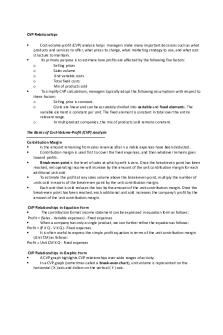CVP Relationships Notes PDF

| Title | CVP Relationships Notes |
|---|---|
| Author | Daniel Deskins |
| Course | Principles Of Accounting |
| Institution | Old Dominion University |
| Pages | 4 |
| File Size | 79.1 KB |
| File Type | |
| Total Downloads | 76 |
| Total Views | 157 |
Summary
Paige O'Shaughnessy, Principles of Managerial Accounting ...
Description
Chapter 5: Cost-Volume-Profit Relationships 1
The basics of cost-volume-profit (CVP) analysis Cost-volume-profit analysis Tool to help managers understand the relationships among cost, volume, and profit. Focuses on how profits are affected by the following five factors: 1. Selling prices 2. Sales volume 3. Unit variable costs 4. Total fixed costs 5. Mix of products sold Vital tool in many business decisions: 1. What products and services to offer 2. What prices to charge 3. What marketing strategy to use 4. What cost structure to implement
Contribution Margin Sales – variable expenses = contribution margin Contribution margin may be shown on a per unit basis or as a total amount. NOTE: to calculate selling price per unit and variable cost per unit divide the total by the quantity to arrive at the per unit amount. Remember, variable expense % + contribution margin % = sales = 100%
CVP in equation form Profit = (sales – variable expenses) – fixed expenses Remember, sales and variable expenses can be broken down to a unit amount if unit sales price/variable costs are known or if the quantity sold is known. Break-even point level of sales at which profit is zero note that once the break-even point has been reached, net operating income will increase by the amount of the unit contribution margin for each additional unit sold to calculate: o fixed expenses/unit Contribution Margin = unit sales to break-even o fixed expenses/contribution margin ratio = dollar sales to break even can also calculate dollar sales to break-even by multiplying unit sales to breakeven by unit selling price
CVP Relationships in Graphic Form
Way to illustrate relationships among revenue, cost, profit, and volume. Highlights CVP relationships over wide ranges of activity Also called a break-even chart Three lines are charted. x-axis (horizontal) is unit volume, and the y-axis (vertical) is dollars Fixed expense
Chapter 5: Cost-Volume-Profit Relationships 2
Total costs (fixed plus variable) Sales The fixed expense line is parallel to the volume axis At zero units the total cost line begins at the fixed expense level. At zero units the sales line is at zero dollars. Lines can be drawn by calculating the total costs and total sales at a sales volume greater than zero and connecting the points from zero volume to the plotted points. Profit graph is a simpler form and plots as a single straight line. Compute the profit at two different sales volumes, plot the points, and then connect them with a straight line. The break-even point on the profit graph is the volume of sales at which profit is zero.
Contribution Margin Ratio (CM ratio)
it is the contribution margin as a percentage of sales Contribution margin/sales = CM ratio o Can be calculated using total contribution margin/total sales or unit CM/unit selling price Shows how the contribution margin will be affected by a change in total sales The impact on net operating income of any given dollar change in total sales can be computed by applying the CM ratio to the dollar change Variable expense ratio = 1 – contribution margin ratio, or variable expenses/sales Incremental analysis – a simpler and more direct and focuses attention on the specific changes that would occur as a result of the decision. o considers only the revenue, cost, and volume that will change if the new program is implemented.
Target Profit and Break-even Analysis Target Profit Analysis
key uses of CVP analysis estimate what sales volume is needed to achieve a specific target profit Equation method: profit = (unit CM X Q ) – fixed expense, solve for Q Formula method: Q = (Target profit + fixed expense)/Unit CM o Short-cut version of the equation method Target profit analysis in terms of sales dollars: profit =( CM ratio X sales) – fixed expenses OR (Target Profit + Fixed Expenses)/ CM ratio
Break-even Analysis
As a form of target profit analysis we can look at break-even analysis as the level of sales at which the company’s profit is zero.
The Margin of Safety
The excess of budgeted or actual sales dollars over the break-even volume of sales dollars. Amount by which sales can drop before losses are incurred. Higher the margin of safety, the lower the risk of not breaking even and incurring a loss. Margin of safety in dollars = total budgeted (or actual) sales – break-even sales
Chapter 5: Cost-Volume-Profit Relationships 3
Margin of safety percentage = margin of safety in dollars/ total budgeted (or actual) sales in dollars In a single-product company the margin of safety can also be expressed in terms of the number of units sold by dividing the margin of safety in dollars by the selling price per unit.
CVP Considerations in choosing a cost structure Cost Structure and Profit Stability
Cost structure refers to the relative proportion of fixed and variable costs in an organization. No one structure is better
Operating Leverage
A measure of how sensitive net operating income is to a given percentage change in dollar sales. Acts as a multiplier. If operating leverage is high, a small percentage increase in sales can produce a much larger percentage increase in net operating income. Degree of operating leverage = contribution margin/ net operating income o Can be used to quick estimate what impact various percentage changes in sales will have on profits, without the necessity of preparing detailed income statements o The effect of operating leverage can be dramatic o If a company is near its break-even point, then even small percentage increases in sales can yield large percentage increases in profits.
Structuring Sales Commissions
Compensation to salespeople can be commission based on sales, a salary, or a combination Commissions based on sales dollars can lead to lower profits. o May be best to base commissions on contribution margin as salespeople will want to sell the mix of products that maximizes contribution margin. This will maximize the company’s profit providing that fixed costs are not affected by the sales mix.
Sales Mix Definition of sales mix
Refers to the relative proportions in which a company’s products are sold. Idea is to achieve the combination, or mix that will yield the greatest profits. Profits will be greater if high-margin rather than low-margin items make up a relatively large proportion of total sales.
Sales mix and break-even analysis
Break-even point depends on the mix in which the various products are sold. In preparing a break-even analysis, it is assumed the sales mix will not change.
Assumptions of CVP Analysis
Assumptions
Chapter 5: Cost-Volume-Profit Relationships 4 1. 2. 3. 4.
Selling price is constant Costs are linear and can be accurately divided into variable and fixed elements Sales mix is constant in multiproduct companies Inventories do not change in manufacturing companies. Number of units produced equals the number of units sold. Greatest danger live in relying on simple CVP analysis when a manager is contemplating a; large change in volume that lies outside of the relevant range. o In these situations the model can be adjusted to take into account anticipated changes in selling prices, fixed costs, and the sales mix....
Similar Free PDFs
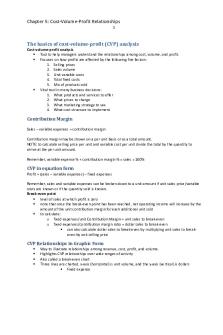
CVP Relationships Notes
- 4 Pages

06 CVP Relationships
- 51 Pages
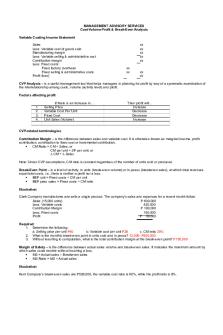
CVP Analysis - CVP
- 9 Pages
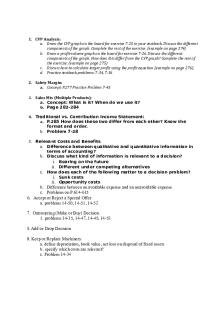
CVP - Chapter 6 on CVP
- 2 Pages

CVP Analysis - Lecture notes 9
- 2 Pages

CVP Drill
- 4 Pages

MAS CVP Reviewer
- 26 Pages

COM 316 Chapter 7: CVP
- 10 Pages
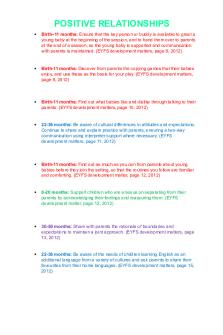
positive relationships
- 4 Pages
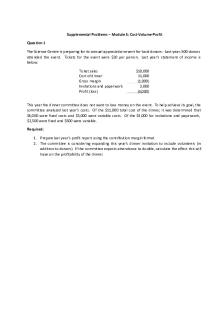
Supplemental Problems CVP up
- 5 Pages

Chapter 22 - CVP Analysis
- 52 Pages

CVP guide questions
- 20 Pages
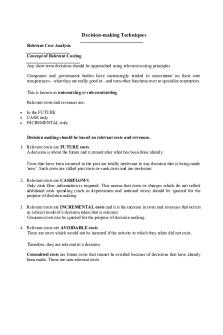
05-Relevant Costing & CVP
- 21 Pages
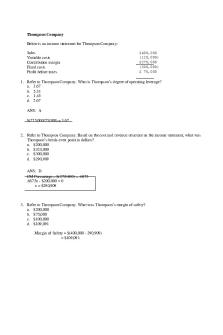
4.5 CVP3 - CVP 3 answers?
- 4 Pages
Popular Institutions
- Tinajero National High School - Annex
- Politeknik Caltex Riau
- Yokohama City University
- SGT University
- University of Al-Qadisiyah
- Divine Word College of Vigan
- Techniek College Rotterdam
- Universidade de Santiago
- Universiti Teknologi MARA Cawangan Johor Kampus Pasir Gudang
- Poltekkes Kemenkes Yogyakarta
- Baguio City National High School
- Colegio san marcos
- preparatoria uno
- Centro de Bachillerato Tecnológico Industrial y de Servicios No. 107
- Dalian Maritime University
- Quang Trung Secondary School
- Colegio Tecnológico en Informática
- Corporación Regional de Educación Superior
- Grupo CEDVA
- Dar Al Uloom University
- Centro de Estudios Preuniversitarios de la Universidad Nacional de Ingeniería
- 上智大学
- Aakash International School, Nuna Majara
- San Felipe Neri Catholic School
- Kang Chiao International School - New Taipei City
- Misamis Occidental National High School
- Institución Educativa Escuela Normal Juan Ladrilleros
- Kolehiyo ng Pantukan
- Batanes State College
- Instituto Continental
- Sekolah Menengah Kejuruan Kesehatan Kaltara (Tarakan)
- Colegio de La Inmaculada Concepcion - Cebu

